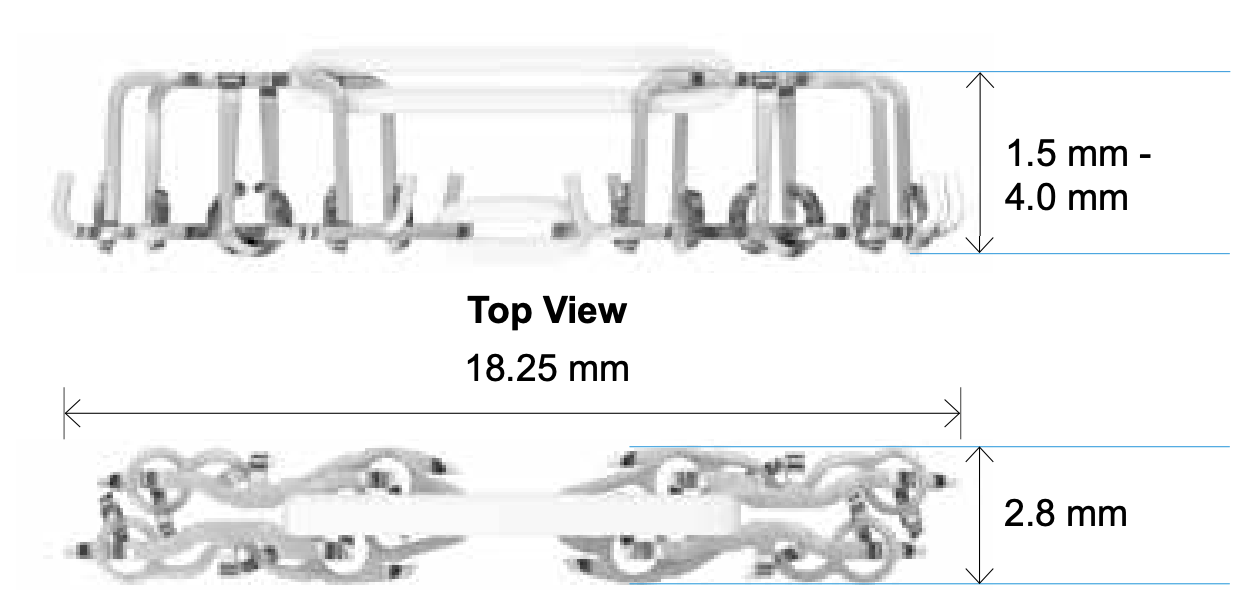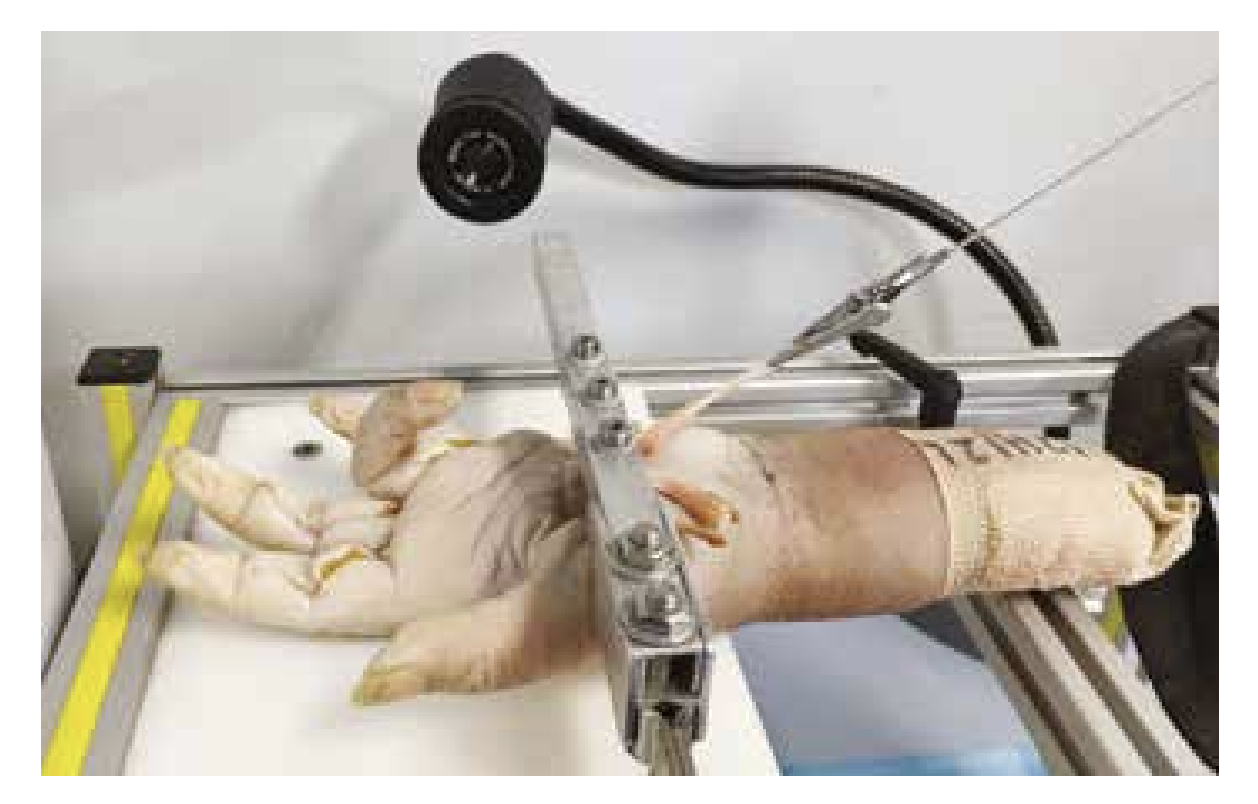CoNextions TR Zone 2 Glide White Paper
Objective
The purpose of this study was to compare the cross-sectional area of the repair site and glide force obtained during simulated tendon gliding before and after repairs of Zone 2 Flexor Digitorum Profundus (FDP) tendons with the CoNextions TR Tendon Repair System or a conventional suture repair technique.
Background
Suture has been the standard of care for the repair of lacerated or severed tendons since it was first documented over 1,800 years ago (Mankse 2005). Despite advancements in biomaterials, operative techniques, and rehabilitation protocols, postoperative complications following tendon repair are still common. One of the prevailing principles of tendon repair is to reduce additional bulk and increase resistance to tendon gliding caused at the repair site with bulkier repairs demonstrated to impede normal tendon gliding (Zhao 2004).
The CoNextions TR Tendon Repair System was designed to provide an alternative to suture for the repair of tendons. The implant consists of two identical stainless-steel anchors implanted simultaneously into the injured tendon. The tendon repair site is centered between the anchors which are connected by two loops of ultra-high molecular weight polyethylene (UHMWPE) fiber (Figure 1).
The CoNextions TR Implant is provided in two pieces pre-loaded into an implant mechanism. During implant deployment the top and bottom pieces of the implant form together securing the reapproximated ends of the injured tendon. The system was designed for the repair of tendons that are 1.5 to 4 mm in thickness and at least 3 mm in width and requires at least 20 mm (10 mm/side) of surgical site access for proper implant deployment.

Specimen Preparation
Six human cadaveric hand specimens were dissected such that Zone 2 of the index, long, ring, and small fingers was exposed. The flexor digitorum profundus (FDP) tendon was freed to allow the corresponding tendon to flex each of the fingers of the hand. The fingers were fully extended, and the FDP tendons were marked 1 cm from the distal margin of the A2 pulley.
Repair Measurements – Cross-Sectional Area
The width and height of each FDP tendon was measured with digital calipers at the marked location prior to and after the simulated repairs. These measurements were used to calculate an estimated cross-sectional area (CSA) of the repair, defined as the approximate area of an ellipse.
Glide Force Testing
The entire hand was placed in the glide test fixture as shown in Figure 2.

An alligator clip was used to connect a cable from the Instron® machine (Instron 2243 Series Universal Testing Device, Instron Corporation) to the selected FDP tendon. The finger was placed in full extension and a load of 2-3 N was manually applied to take slack of the test setup. Tensile load was applied to the tendon to simulate full flexion at a rate of 20 mm/sec. The tendon was then transected at the previously described location and repaired with either a CoNextions TR implant or a 4-strand locked cruciate suture repair (Ethibond Excel® 3-0 Braided Polyester Suture) with a running epitendinous suture (PROLENE® 5-0 Suture). All repairs were performed by a fellowship-trained hand surgeon. Following repair, the glide force test was repeated. This process was repeated for all 4 FDP tendons in each hand with 3 hand specimens (12 tendons) being allocated to each repair group.
Results
Cross-Sectional Area of Tendon Repairs
The average percent increase in the CSA of tendons repaired with a CoNextions TR implant was 79% compared to an average increase of 86% in the CSA of tendons repaired with suture (Table 1).

Glide Force Testing
The average percent increase in the maximum glide force for tendons repaired with a CoNextions TR Implant was 55% compared to an average increase of 119% in the glide force of tendons repaired with suture (Table 2).

Conclusion
The CoNextions TR System demonstrated superior performance in repair bulk and resistance to gliding compared to 4-strand locking cruciate suture repairs for Zone 2 FDP tendons.
References
- Manske P. History of flexor tendon repair. Hand Clin 2005;221(2):123-7.
- Zhao C, et al. Effect of gap size on gliding resistance after flexor tendon repair. JBJS (Am) 2004;86(11):2482-8.
Other Reads:
CoNextions TR Zone 4 Glide White Paper | Biomechanical Comparison of Repair Strength | CoNextions ASSH Abstract White Paper
This document is intended solely for the use of healthcare professionals. Benchtop testing may not be indicative of clinical performance. The information presented is intended to demonstrate a CoNextions Inc. product. CoNextions does not practice medicine and recommends that surgeons be trained in the use of any particular product before using it in surgery. A surgeon must always rely on his or her own professional clinical judgment when deciding whether to use a particular product when treating a particular patient. CoNextions does not dispense medical advice and recommends that surgeons be trained in the use of any particular product before using it in surgery. Individual results will vary based on health, weight, activity and other variables. Not all patients are candidates for this product and/or procedure. Products may not be available in all markets because product availability is subject to the regulatory and/or medical practices in individual markets. Please contact your CoNextions representative if you have questions about the availability of CoNextions products in your area. For indications, contraindications, warnings, precautions, potential adverse effects and patient counselling information, see the package insert or contact your local representative. Visit www.conextionsmed.com for additional product information. CoNextions owns, uses, or has applied for the following trademarks: CoNextions, Coronet, Revolutionizing Tendon Repair. Sawbones is a trademark of Pacific Laboratories Inc. FiberWire is a trademark of Arthrex, Inc. Instron is a trademark of Illinois Tool Works Inc.
MC0010.A
© 2021 CoNextions Inc. All Rights Reserved. U.S and Foreign Patents Pending. Patented in the U.S. Patent No. 10,219,804.
